Synology DS920+ vs DS1522+ Plex NAS Comparison – Which Should You Buy?
Today I want to compare the hardware on offer inside the Synology DS1522+ NAS (released in Summer 2022) and compare it with the much older, but hugely popular Synology DS920+ NAS (released over two years ago in Summer 2020). However, unlike previous comparisons of these two NAS (such as the hardware and software comparison HERE that I published a few months ago) today I want to compare how the DS920+ and DS1522+ perform as a Plex Media Server, with a series of 720p, 1080p and 4K tests. I have already tested these two NAS devices individually, but never directly compared their performance side by side. Now that a number of prominent Synology NAS releases have arrived with AMD Ryzeen embedded processors (such as the AMD Ryzen R1600 and V1500), many are wondering if they should choose to buy the older and more affordable Synology NAS drives that still feature Intel embedded/integrated graphics, such as the DS920+ with it’s J4125 Celeron CPU. So, let’s get this test up and running. First, we need to take a quick look at the individual hardware of these two NAS devices.
Note – a draft version of this article was published in error; apologies if you saw/received the incredibly bare-bones version!
Note 2 – Video Version of this Plex comparison can be viewed HERE on YouTube
| Synology DS920+ NAS | Synology DS1522+ NAS |
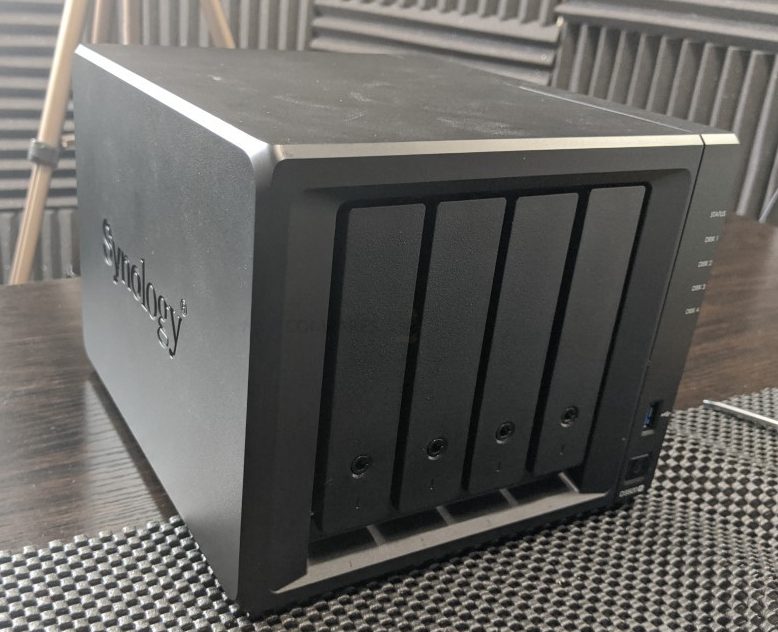 |
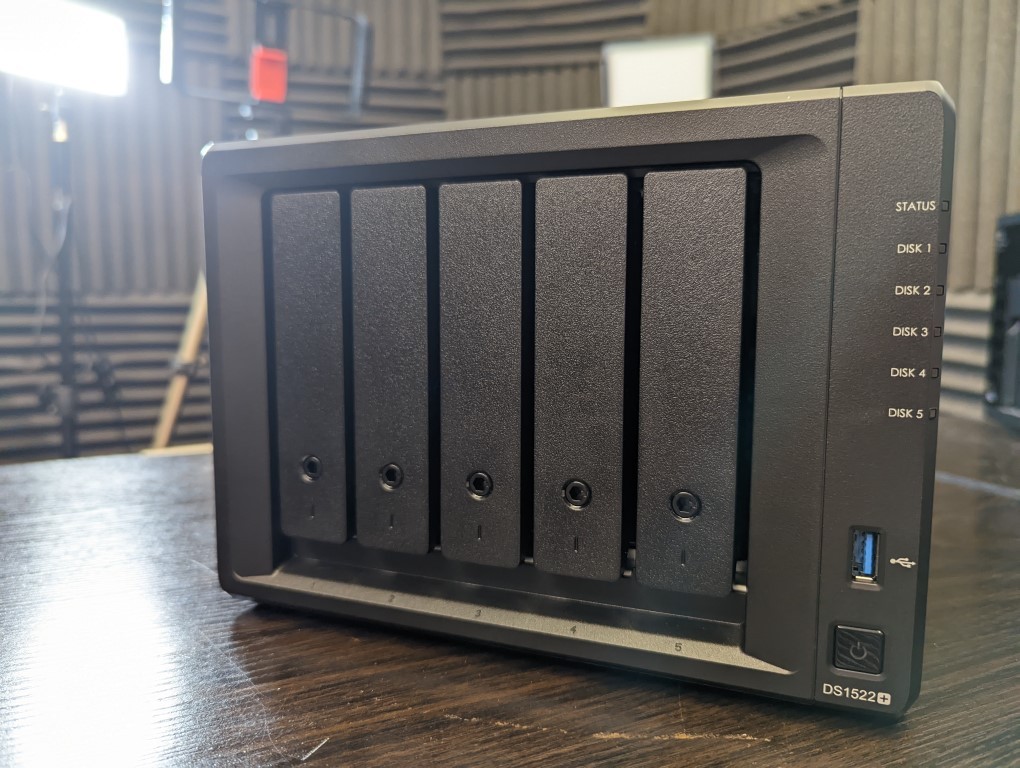 |
Synology DS920+ vs DS1522+ Plex NAS Comparison – Internal Hardware
The 4 and 5-Bay Diskstation releases from Synology have always been one of the most interesting tiers of the brand’s desktop solutions. The reason for this is that all too often this scale of system serves as a bridging point between Prosumer & SOHO systems and the small/medium business hardware in their portfolio. This is demonstrated first in the scale of the available RAID 5/6 storage, but then more so in the scalability and upgradability of these two volumes system, allowing one to two expansions, greater network connectivity (arriving with 2x or 4x LAN ports) and better internal hardware than the more domestic targetted solutions – often with the internal hardware differing considerably between each periodic 2-3yr refresh by the brand. Let’s first look at the internal hardware of these two NAS’ to see how much they differ. The DS920+ NAS first arrived on the scene with some great hardware advantages over the rest of the plus series 2020 systems (DS720+, DS420+, etc), arriving with a 4 Core Intel Celeron Processor that featured integrated graphics, 4GB of DDR4 2666Mhz memory and NVMe SSD upgrade slots. In the two years since its release though, Synology clearly decided to make some big changes in the base level architecture of the plus series and specifically in the DS1522+ to make it considerably more scalable and general business/file-ops focused. The newer DS1522+ features a dual-core AMD Ryzen embedded R1600 that, although arriving with half the cores of the Celeron in the DS920+, has a higher CPU frequency and total achievable frequency in turbo/burst when needed. That said, users will be surprised to learn that this CPU also does not feature embedded graphics, so therefore the DS1522+ will be less CPU efficient at handling multimedia or VM deployment than the DS920+.
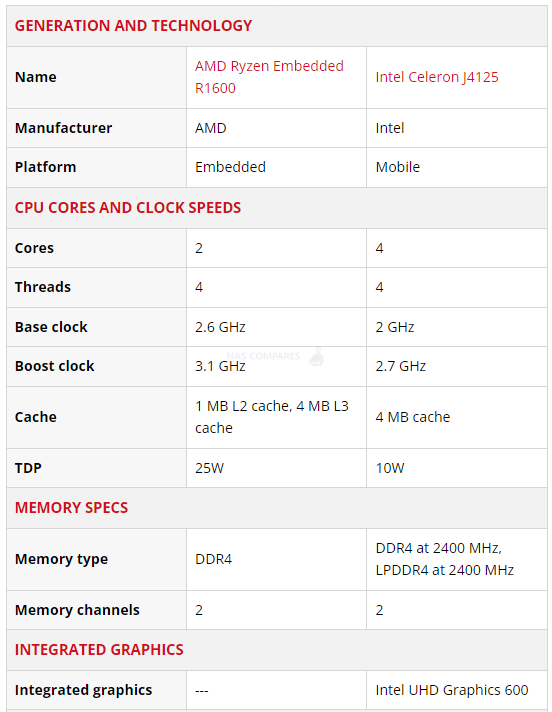
Though both systems feature DDR4 memory, the DS920’s maximum 8GB of memory is beaten by the DS1522+ thanks to its use of much more impressive ECC (error code correction) memory to identify and repair any bit level write errors and can also be scaled to a considerably higher 32GB of memory (arriving with 8GB by default).
| NAS Model | DS920+
|
DS1522+
|
| CPU Model | Intel Celeron J4125 | AMD Ryzen R1600 |
| CPU Quantity | 1 | Embedded Ryzen |
| CPU Architecture | 64-bit | 64-bit |
| CPU Frequency | 4-core 2.0 – 2.7 GHz | 2-core 2.6 – 3.1 GHz |
| Hardware Encryption Engine (AES-NI) | Yes | Yes |
| Integrated Graphics | Yes | No |
| CPU Cache | 4 MB cache | 1 MB L2 cache, 4 MB L3 cache |
| Memory | ||
| System Memory | 4GB DDR4 non-ECC SODIMM | 8GB DDR4 ECC SODIMM |
| Memory Module Pre-installed | (4GB On-board) | 8 GB (8GB x 1) |
| TDP | 10W | 25W |
| Total Memory Slots | 1 | 2 |
| Maximum Memory Capacity | 8GB | 32 GB (16 GB x 2) |
| System Fan | 92 mm x 92 mm x 2 pcs | 92 mm x 92 mm x 2 pcs |
| Power Supply Unit / Adapter | 100W External | 120W External |
You can find out more about the hardware-specific difference between the Synology DS920+ and DS1522+ NAS in the video below OR via the article HERE. This video/article coves everything from the storage capabilities, ports & connections and extent to which they run/perform in DSM 7.1. Although this article is specifically tailored to look at Plex Media Server performance, I would strongly recommend checking out more information on either of these NAS before you make any decision.
Let’s carry on talking about these two NAS and Plex. What difference des the TYPE of media tha you play make on how these two NAS perform in Plex?
Synology DS920+ vs DS1522+ Plex NAS Comparison – Understanding MEDIA!
Important Terms to Understand in Plex/NAS/Multimedia that will make the DS1522+ or DS920+ NAS Plex Tests Easier to Understand.
- SD, 160p, 240p, 480p, 720p, 1080p, 4K : This is the resolution that the media is being displayed at. The higher the resolution, the larger number of pixels that are available and depending on the original recording quality of the media in question. High resolutions, such as 1080p and 4K require more work to be done by the NAS hardware in order to playback the file. More often than not, a NAS with weak embedded graphics or no embedded graphics at all will be unable to play 4K very well or indeed at all. It is important to remember that just because a NAS brand like Synology says that their latest NAS can natively play back 1080p or 4K media (natively = played using their own NAS software, software client tools and/or DLNA), that does not mean that the DS920+ or DS1522+ will play to the same standard in Plex, as Plex is a 3rd party tool
- Transcoding, Encoding, Decoding : These are all different techniques/names for when a file needs to be changed in order to be better suited to the connected client device connection, strength or hardware. If you are accessing all your media on the local area network (i.e only accessing your plex media at home), then transcoding will rarely be something you will use (unless your media is largely H.265/HEVC based, see earlier). However, perhaps you are accessing your plex library on the train to work or from a sun bed whilst on holiday. Perhaps you have a smaller data bandwidth/allowed MB/GB, maybe a weaker internet connection, perhaps you are using a smaller phone device and you might not need to watch your 4K 50GB Blu-ray rip of the latest Marvel Movie – in these situations, you might well want to access the media on your Synology DS1522+ or DS920+ Plex NAS at a lesser quality than the original version, so transcoding/re-encoding on the fly (as in, at the same time it is being played) is what you would want to do. Remember, transcoding is by far the most heavy-weight thing you will need to do on a NAS. It is also worth remembering that in order for Plex o be able to use the FULL resources of a NAS CPU (such as embedded graphics) that you will need to enable ‘Make My CPU Hurt’ in the Encoder Menu of the Plex NAS Settings menu – this also potentially requires a Plex Pass subscription, depending on the NAS in question
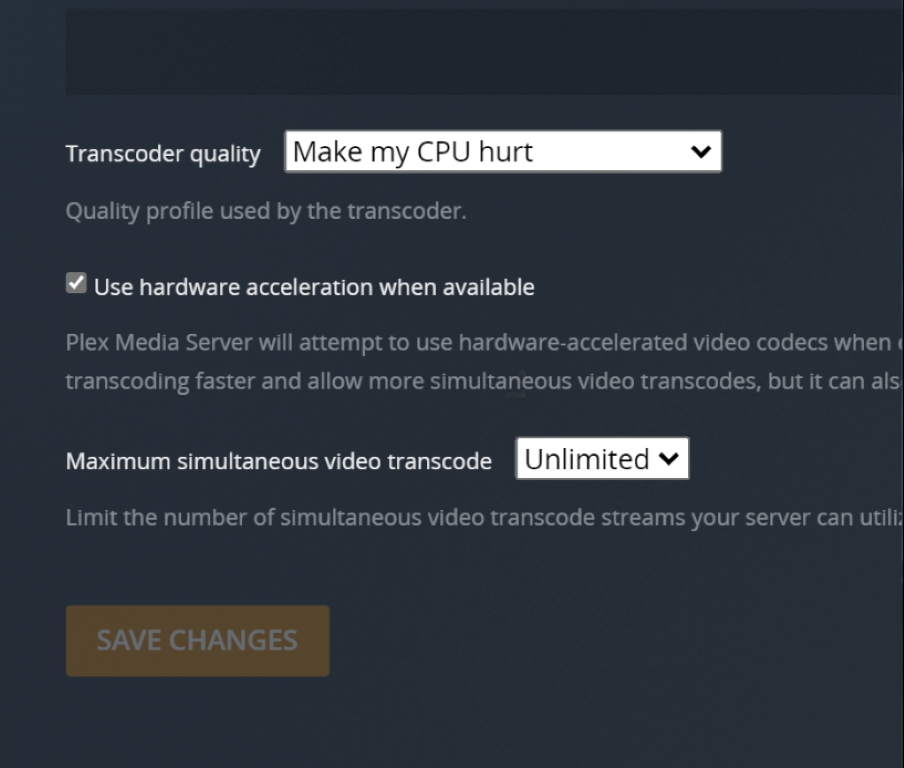
- H.264, HEVC, H.265 : These are compression techniques that are designed to allow large-scale media presentations that were made for a cinema to be viewable from your sofa (with H.265 being the more effective/powerful compression level). H.264 can largely be played by ALL devices, but many devices do not have permission or a license to play H.265/HEVC (they are the same thing). This is because, where H.264 is an easy license and comparatively free to use, H.265/HEVC licencing and patents are spread across multiple providers and allowing a device license to use this compression technique can be complex, expensive or simply impossible. Therefore HEVC/H.265 media will sometimes AUTOMATICALLY need to be converted/transcoded into H.264 etc in order to be played – therefore eating up more system resources. The DS1522+, much like the rest of the Synology NAS range do not arrive with HEVC support by default
- Bitrate : Bitrate is the amount of data encoded for a unit of time, and for streaming is usually referenced in megabits per second (Mbps) for video, and in kilobits per second (kbps) for audio. Higher quality and higher resolution media tends to be of a much higher bitrate
For more information on the most important terms to understand when discussing/researching a NAS as a Plex Media Server can be found in my video below:
Any further questions, you can use the free advice section at the bottom of the page and ask me and Eddie directly.
Synology DS920+ vs DS1522+ Plex NAS Comparison – 720p h.264 3Mbps Video File
The first test was with a very low-end 720p media file:
Virtually no difference in performance and you can likely play a considerable number of these files before the system shows even a hint of difficulty.
Synology DS920+ vs DS1522+ Plex NAS Comparison – 720p h.264 3Mbps Video File
Another 720p file for test two, similar bitrate to test 1:
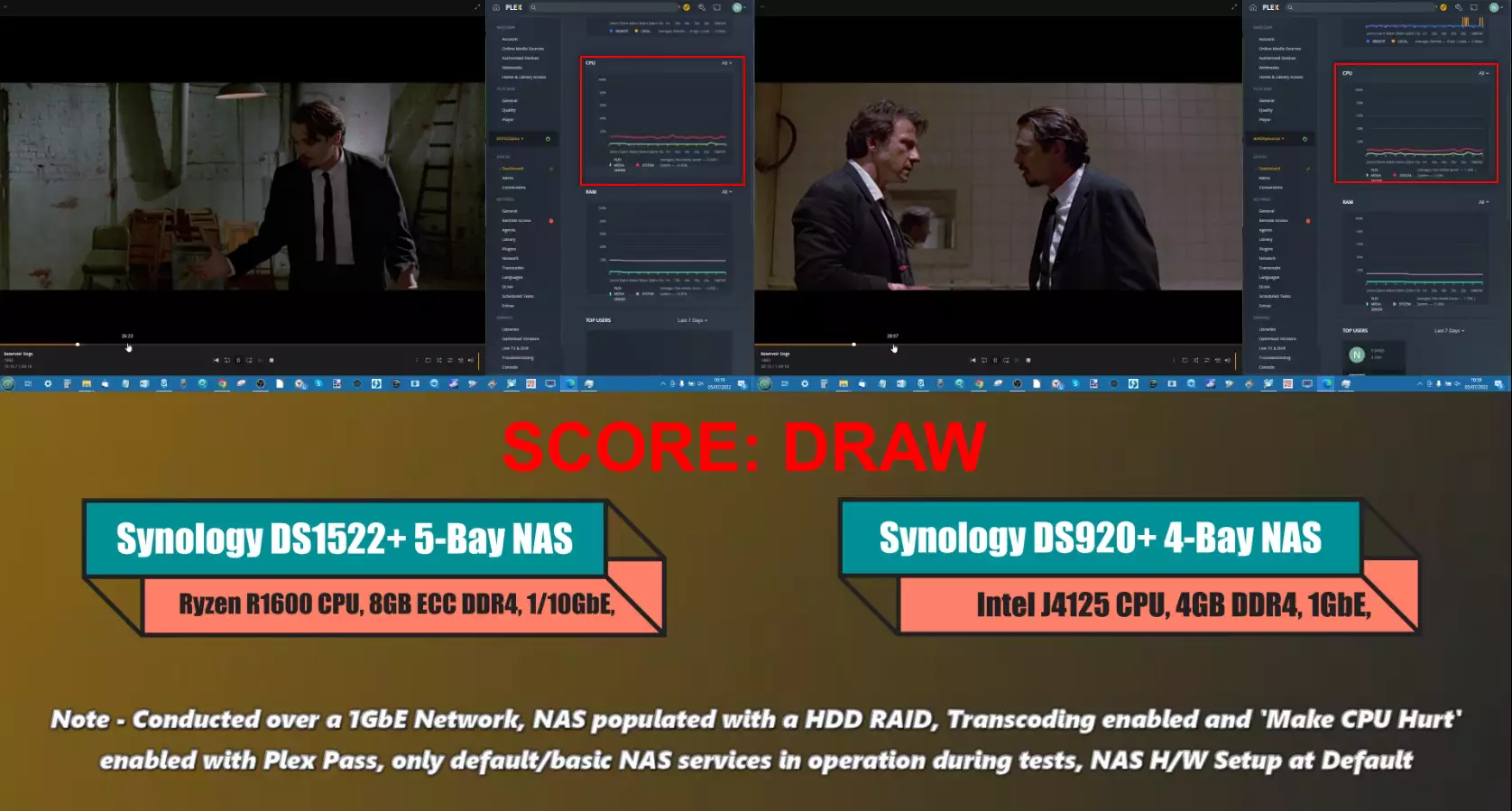
Once again, both the DS920+ and DS1522+ NAS performed near identically in Plex and zero issues were seen.
Synology DS920+ vs DS1522+ Plex NAS Comparison – 720p h.264 3Mbps Video File CONVERT to 480p
Test three was our first transcoding/encoding test. Here I wanted to see how well the systems would cope with having a fle format/playback altered on the fly. If you are watching media on smaller devices, over limited internet connections or using a legacy client device that does not support the file format, compression, codec or scale (size), then transocding is going to be very important. This was 720p down to 480p
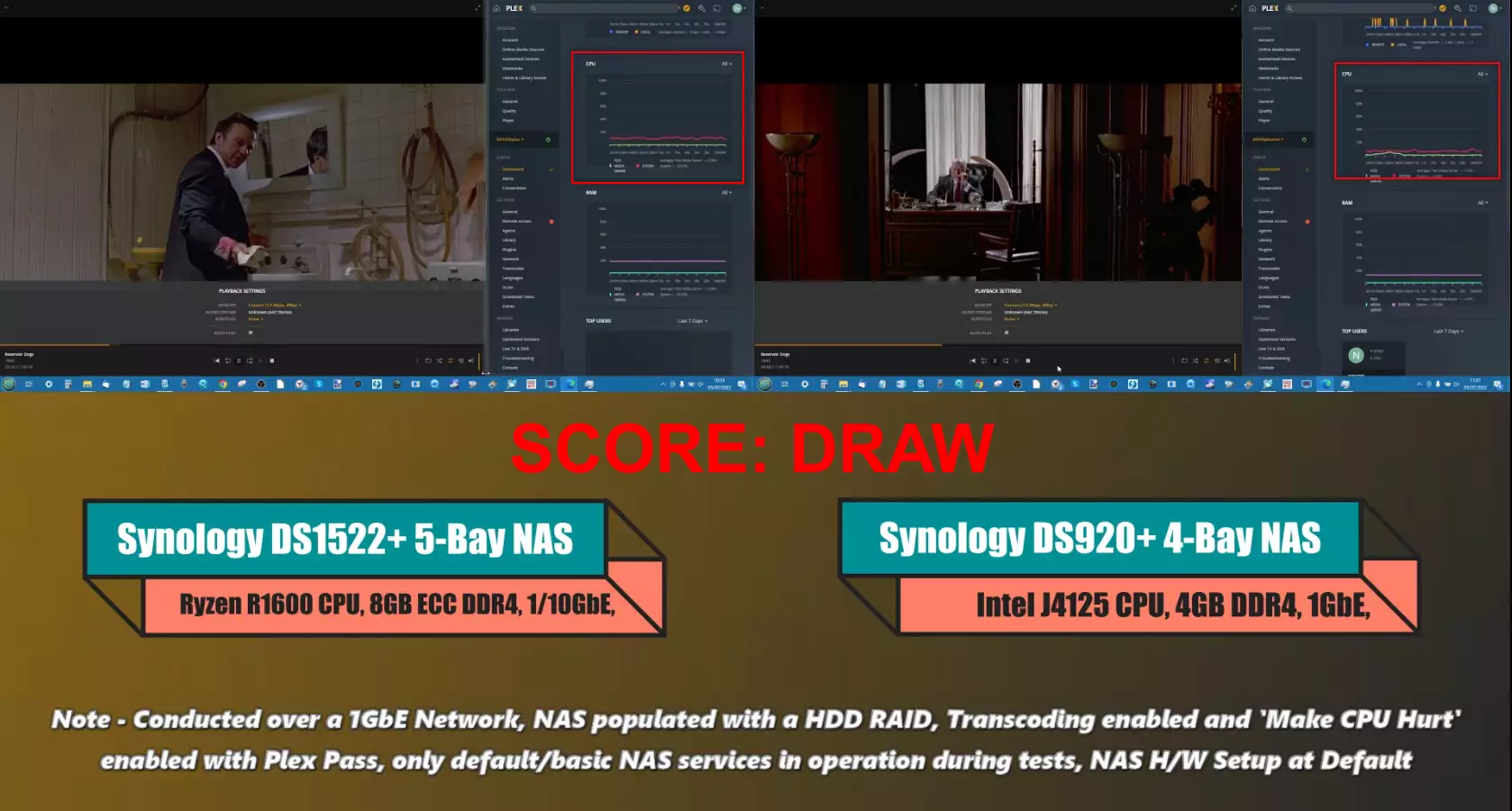
Both played the file and transcoded it very easily. Despite the lack of embedded graphics on the R1600 CPU inside the Synology DS1522+ versus the Intel J4125 Celeron inside the DS920+, things were great on both in this test.
Synology DS920+ vs DS1522+ Plex NAS Comparison – 720p h.264 3Mbps Video File CONVERT to 240p
Time for ANOTHER transcoding test, but this one was s much bigger and more extreme transcode/encode. I wanted to change a 720p file to a 240p file format. This is a pretty aggressive change and one that was mainly picked to simulate heavy Plex NAS use generally (not specific to this format of file/change).
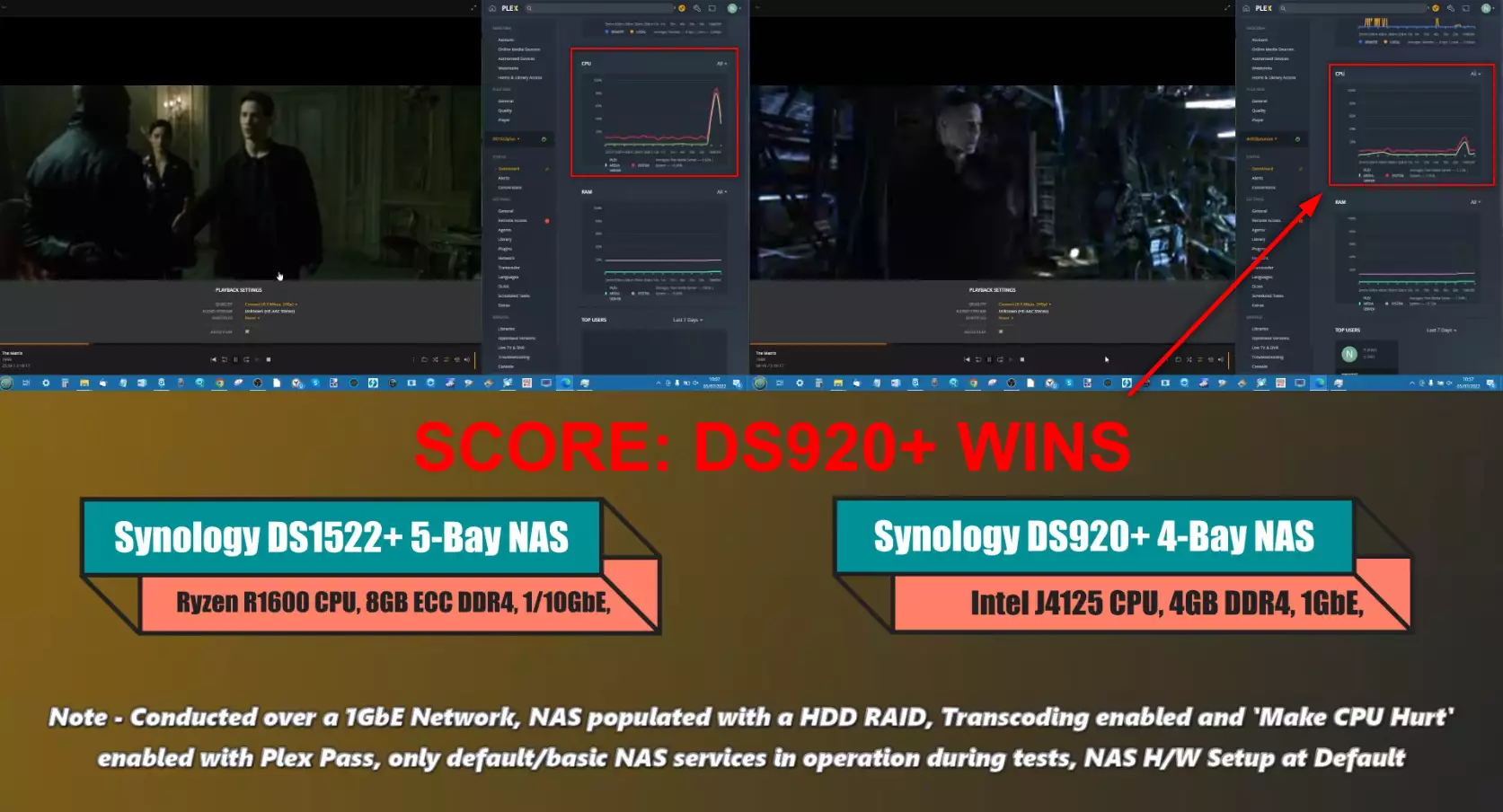
This was the first (and not last) time that the clear advantage of an embedded graphics Intel Celeron CPU inside the DS920+ would prove much more effective in Plex versus the AMD embedded Ryzen R1600 CPU inside the DS1522+ NAS. Both NAS devices did the job, but the R1600 / DS1522+ had to work much, much hardware with software transcoding and raw power.
Synology DS920+ vs DS1522+ Plex NAS Comparison – 1080p h.264 3Mbps Video File
On to 1080p Plex Tests on the DS920+ and DS1522+ NAS. This was a fairly domestic HD 1080p file test, played native.
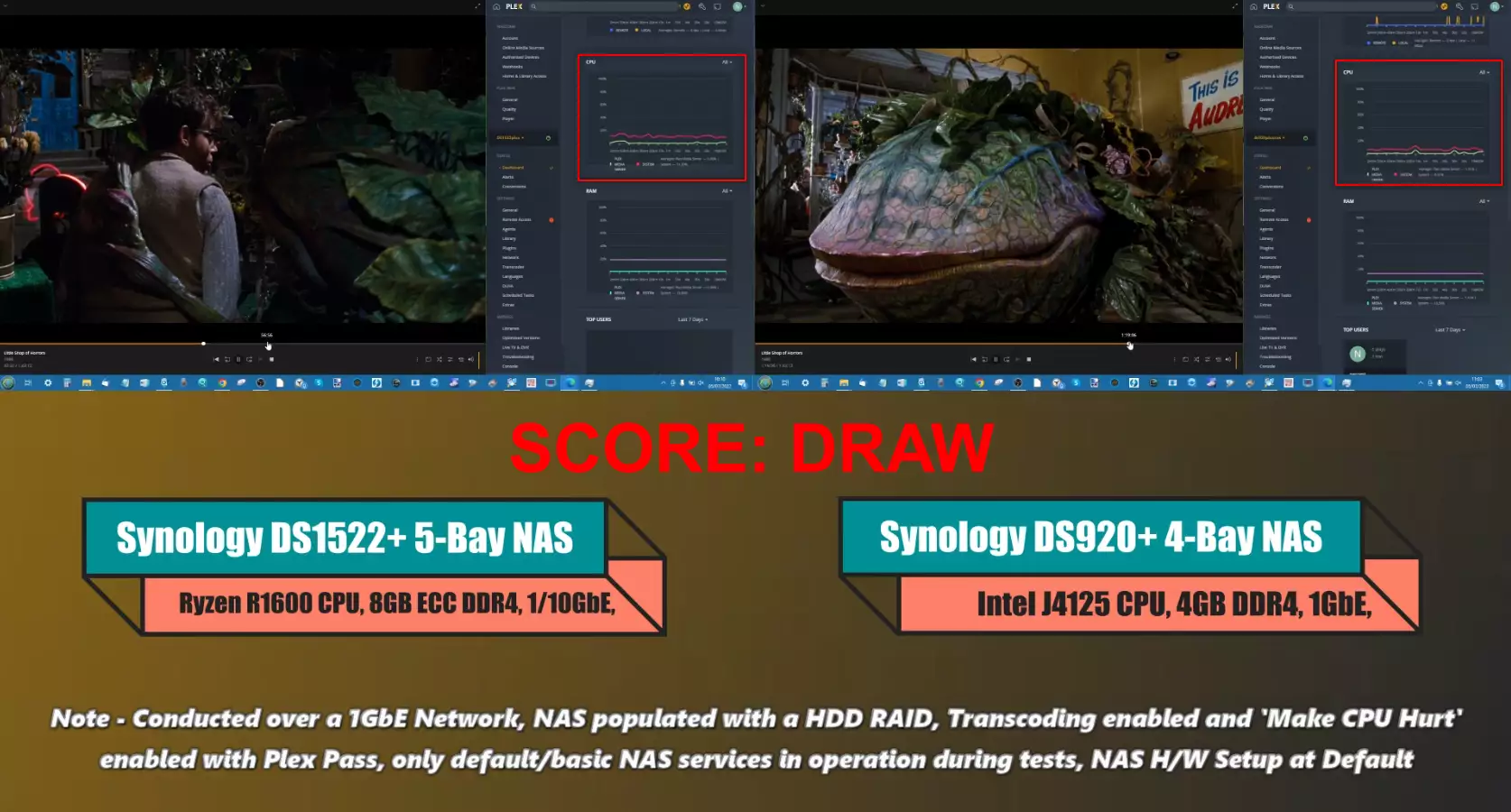
Once again, like the early 720p tests, the DS920+ and DS1522+ performed perfectly well.
Synology DS920+ vs DS1522+ Plex NAS Comparison – 1080p h.264 3Mbps
A slightly more dense 1080p file this time, using the Jellyfish test files.
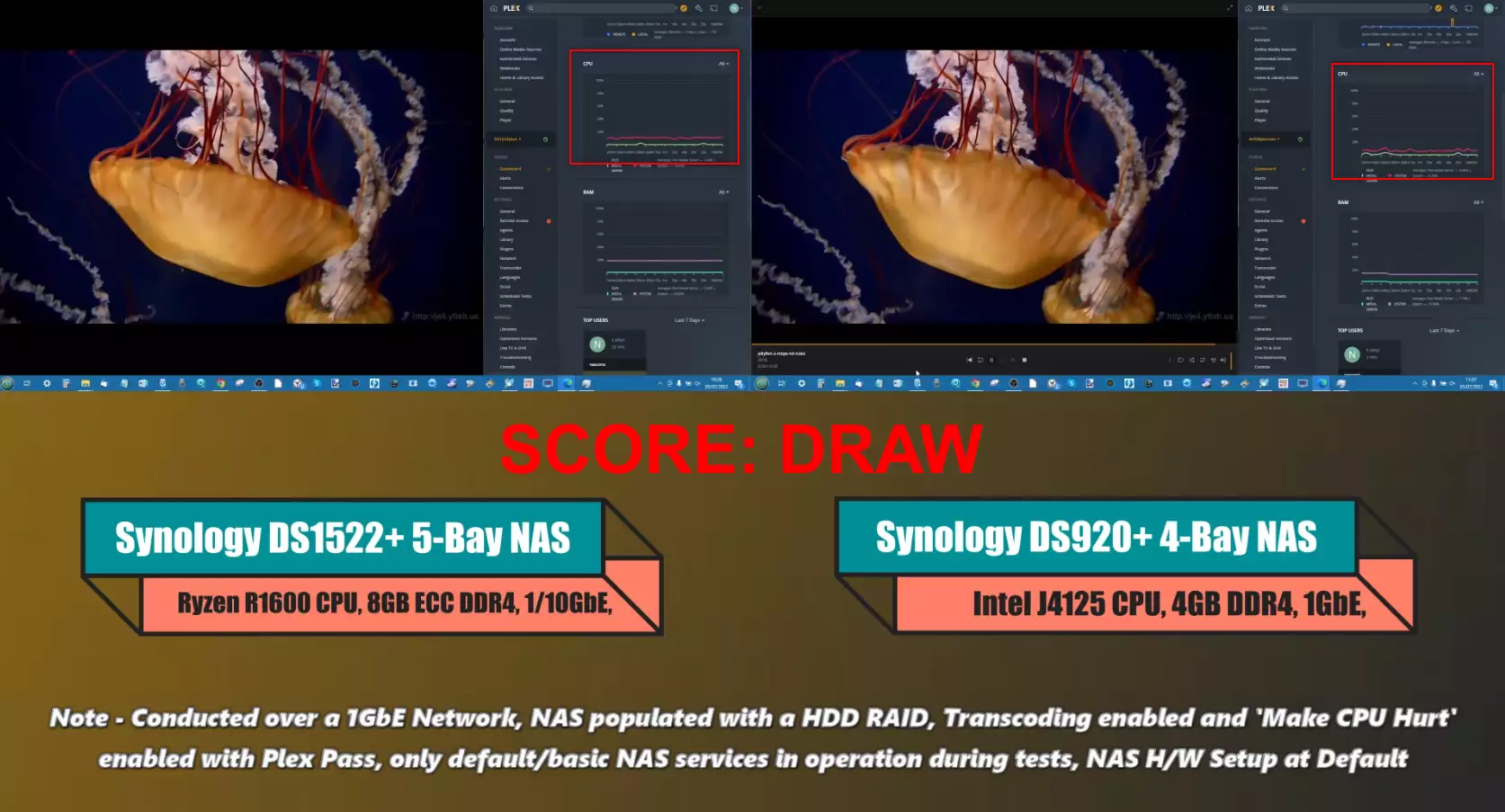
Once again, very clear and even performance by both NAS systems in the 1080p 2nd test without any transcoding on the R1600 and J4125 CPU-powered devices. A clear draw.
Synology DS920+ vs DS1522+ Plex NAS Comparison – 1080p h.264 3Mbps Video File CONVERT to 160p
Time for more transcoding! Transcoding/re-encoding the 1080p file in Plex to an incredibly lowly 160p. Again, I am aware that few users will actually watch 160p, but many will want this support for audio media equivalent workload and/or for large numbers of streams. Ultimately, we want to know the impact on the DS1522+ and DS920+ NAS in plex with these.
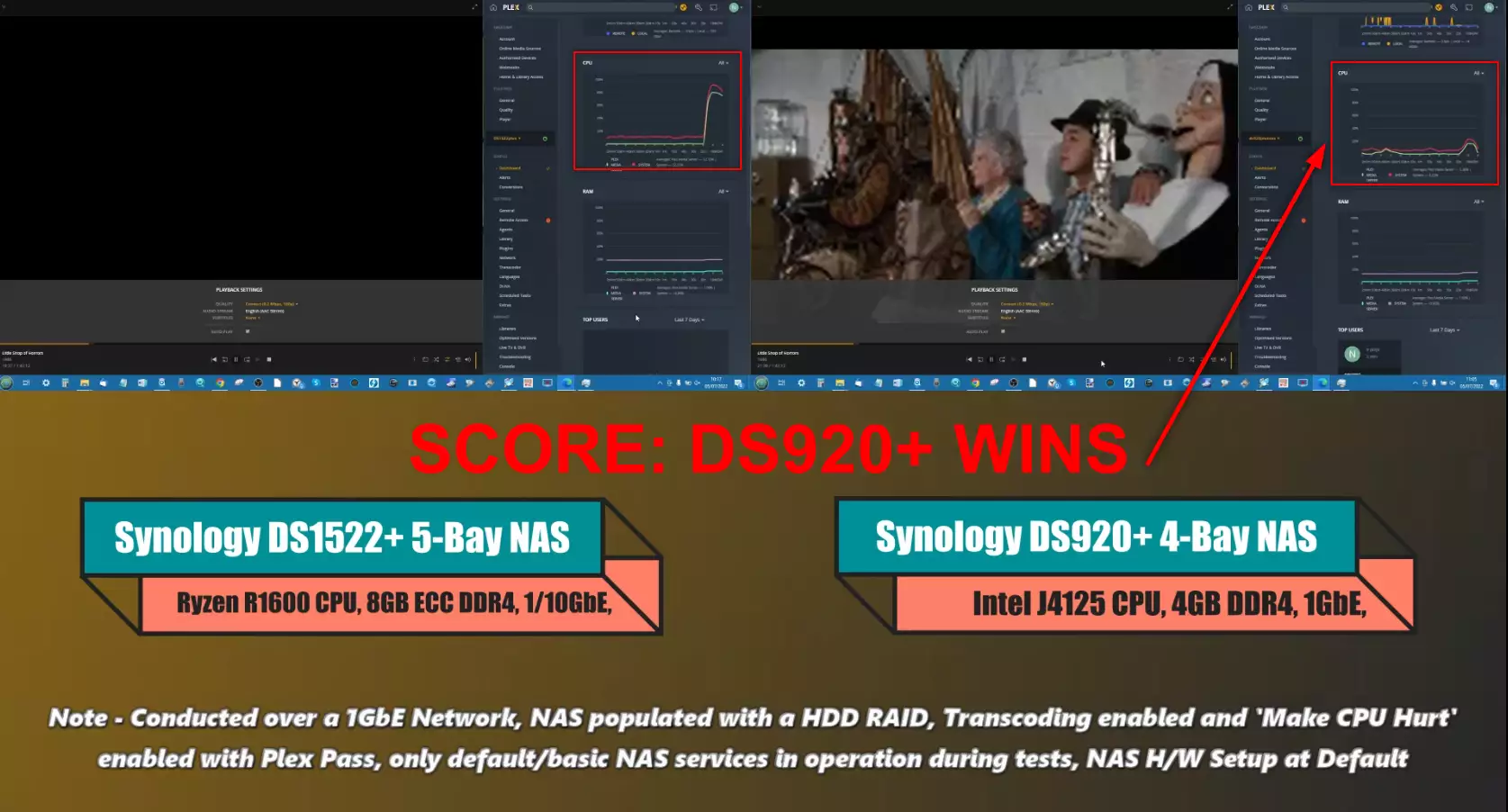
Once again, the onboard/embedded graphics that the Synology DS920+ (Intel Celeron J4125) has over the non-integrated graphics DS1522+ (AMD R1600) clearly resulted in the older 4-Bay NAS getting this job done with very little fuss. Whereas the Neewer 5-Bay NAS was unable to complete the task.
Synology DS920+ vs DS1522+ Plex NAS Comparison – 1080p h.264 100Mbps
Switching things up to an incredibly DENSE 1080p file, I selected the 100Mbps file format (h.264) to see how the DS1522+ and DS920+ would play this natively.
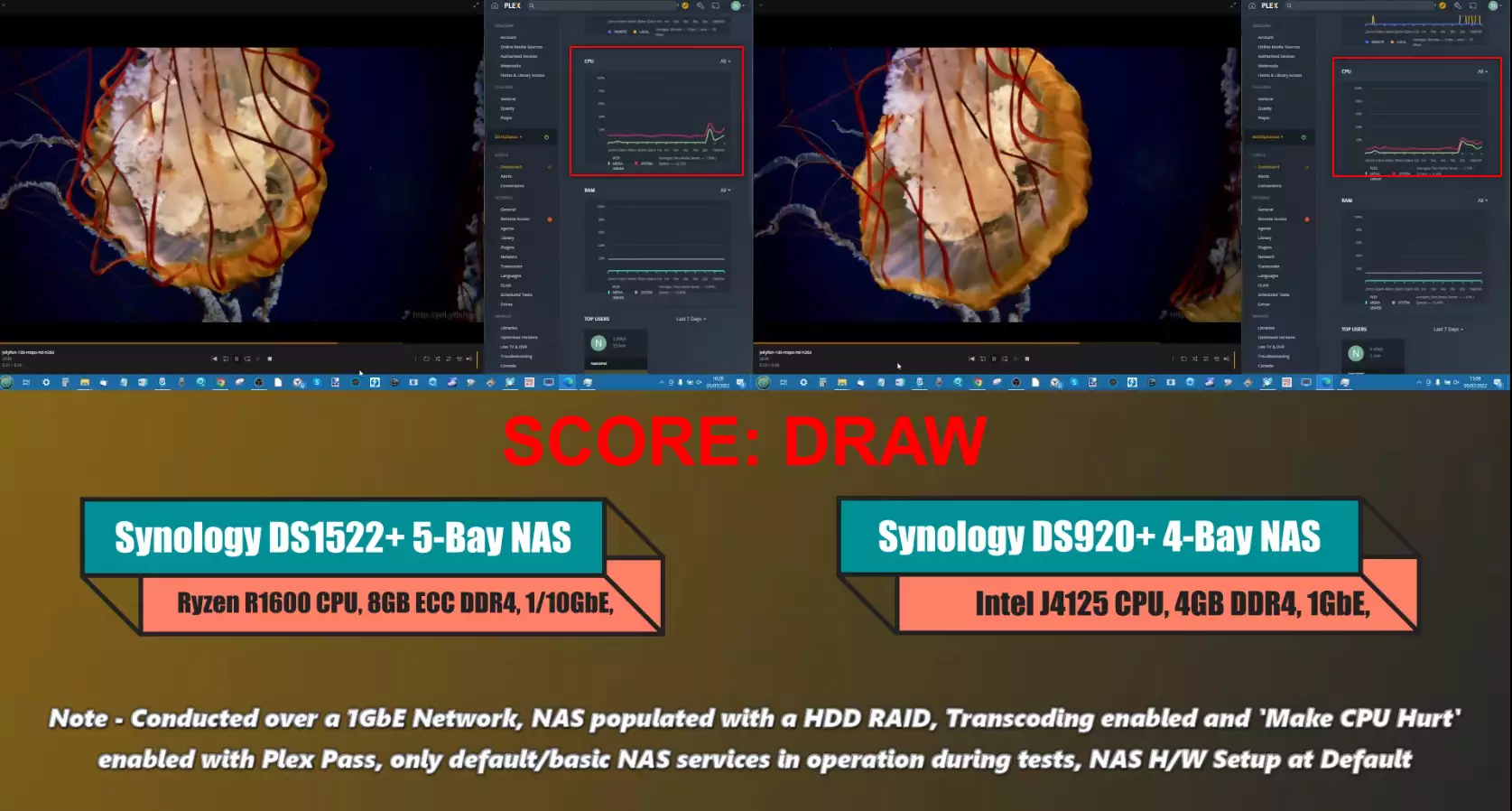
Very similar results on both NAS playing the file natively, which was very positive. The DS1522+ used the tiniest bit more, but in the grand scheme of things, both of these NAS performed exceptionally well in Plex and this heavy-duty 1080P FILE.
Synology DS920+ vs DS1522+ Plex NAS Comparison – 1080p h.265 – HEVC 10bit 10Mbps
Now we move towards a very different ball game. Although the next test was a 10Mbps bitrate 1080p file (remember, the previous test was 10x this density), this time we selected the H.265 / HEVC 10bit file. As mentioned earlier, HEVC (highly efficient video codec) requires licensing by the client hardware manufacturer and software provider (with many/most not including it, relying on the hardware to convert the file to H.264 by default). HEVC is much more space efficient than H.264 and alot more media in 2022+ is arriving in this format. However, converting it (aka Transcoding by another name technically) is a demanding task. Here is how the DS920+ and DS1522+ performed:
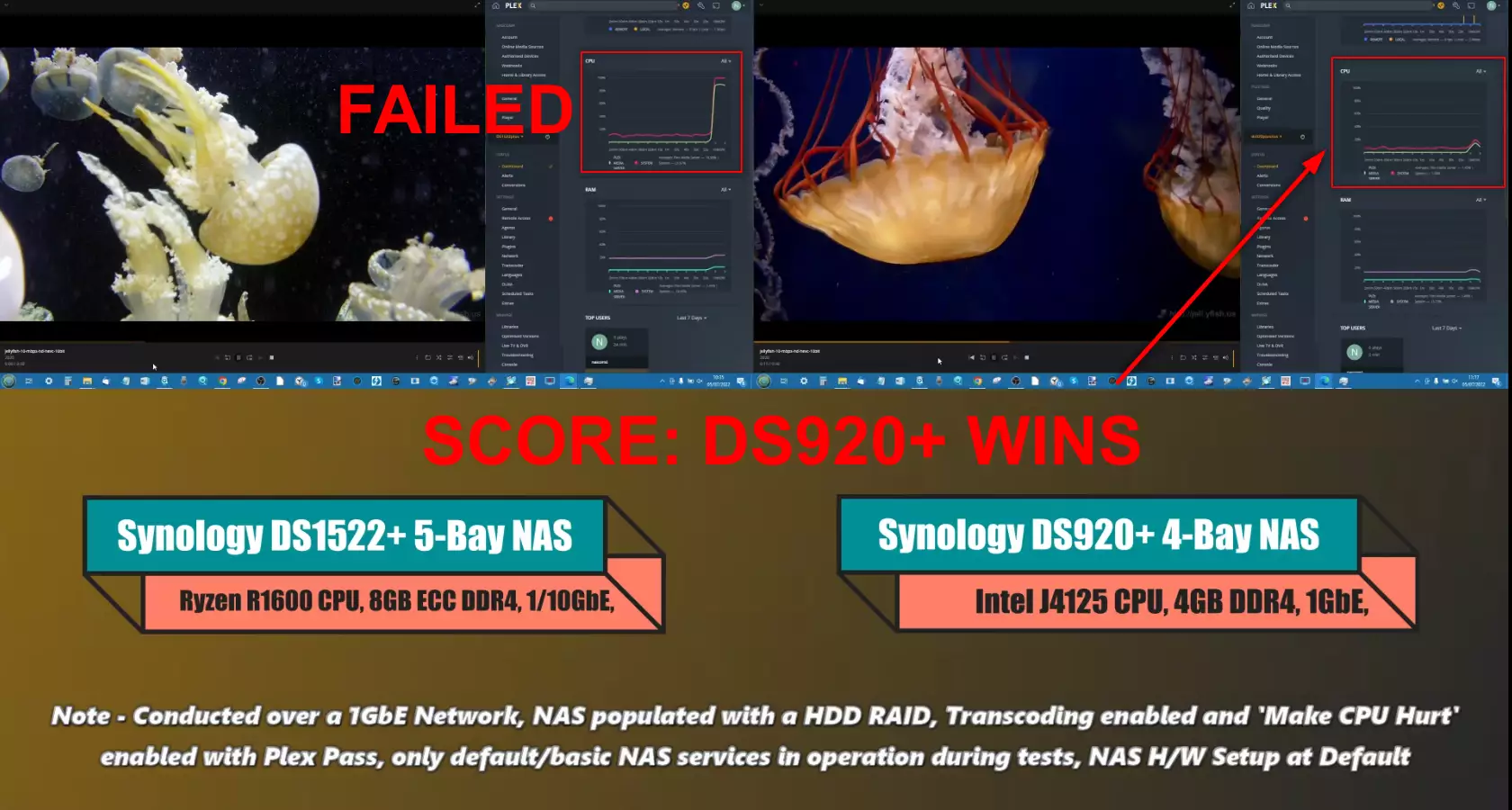
Once again, the Synology DS920+ and it’s Intel Celeron J4125 CPU got the job done with little-to-no fuss, whereas the AMD embedded Ryzen R1600 CPU inside the DS1522+ immediately hit 100% CPU Utilization and failed (taking longer to convert the file per second than an actual second!).
Synology DS920+ vs DS1522+ Plex NAS Comparison – 4K h.264 120Mbps
Next one, time for some 4K PLAYBACK! Now, it is worth highlighting that we ARE looking at quite high-end 4K media here, at 120Mbps – so the odds of you having much media in this format/scale is quite small. Still, 4K TVs and the affordability of 4K media is growing, so we need to test 4K, as well as scale it up for years to come. I wouldn’t normally recommend either of these NAS for 4K Plex use (recommending at least an Intel Pentium, i3 or higher generally), but here is how they performed:
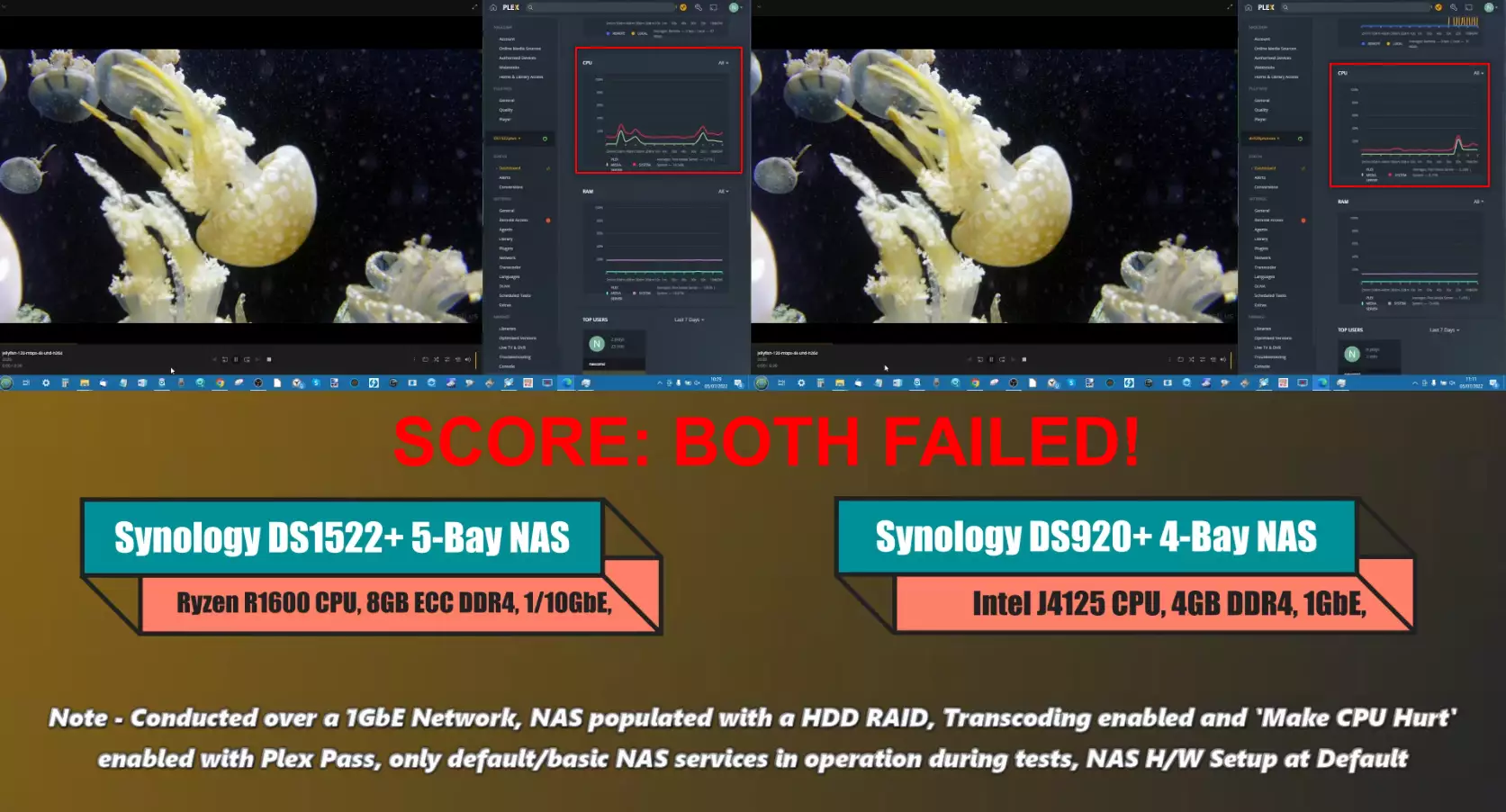
Yep, both NAS devices failed. But again, remember that this is a 120Mbps file. Had we tested 4K at the bitrate of many of the 1080p files, it would have been better. We have some 4K dedicated Plex content coming soon on these NAS devices, so stay tuned!
Synology DS920+ vs DS1522+ Plex NAS Comparison – 4K h.265 – HEVC 120Mbps
Next we tested the same dense 120Mbps 4K files as before, but in the HEVC version. Again, due to the support of this compression level on each of these Synology NAS being limited, converting the file was needed by default. Here is how the DS920+ and DS1522+ NAS performed.
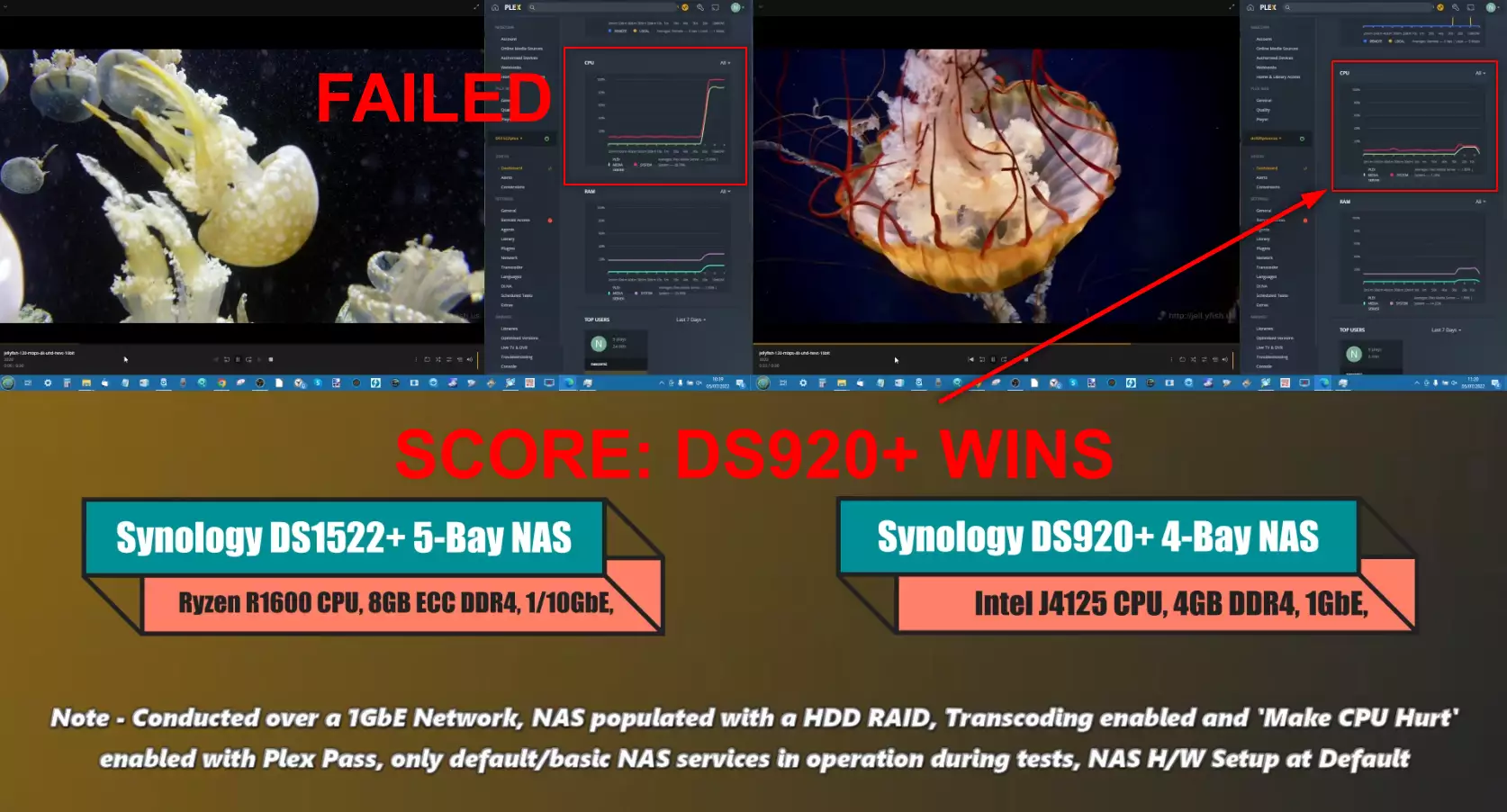
Yep, thanks to the introduction of converting the 4K file being needed, the embedded graphics of the DS920+ CPU saved the day hugely and the result was that although it played (after a small delay) on the Intel-powered DS920+, the DS1522+ and ADM Ryzen hit a wall very quickly.
Synology DS920+ vs DS1522+ Plex NAS Comparison – 4K h.265 – HEVC 200Mbps
Our final test was a 4K file in HEVC, much like the previous test. However this was a HENCH 200Mbps – a herculean task compared with all other tests in this article. Here is the DS920+ and DS1522+ tackled the task.
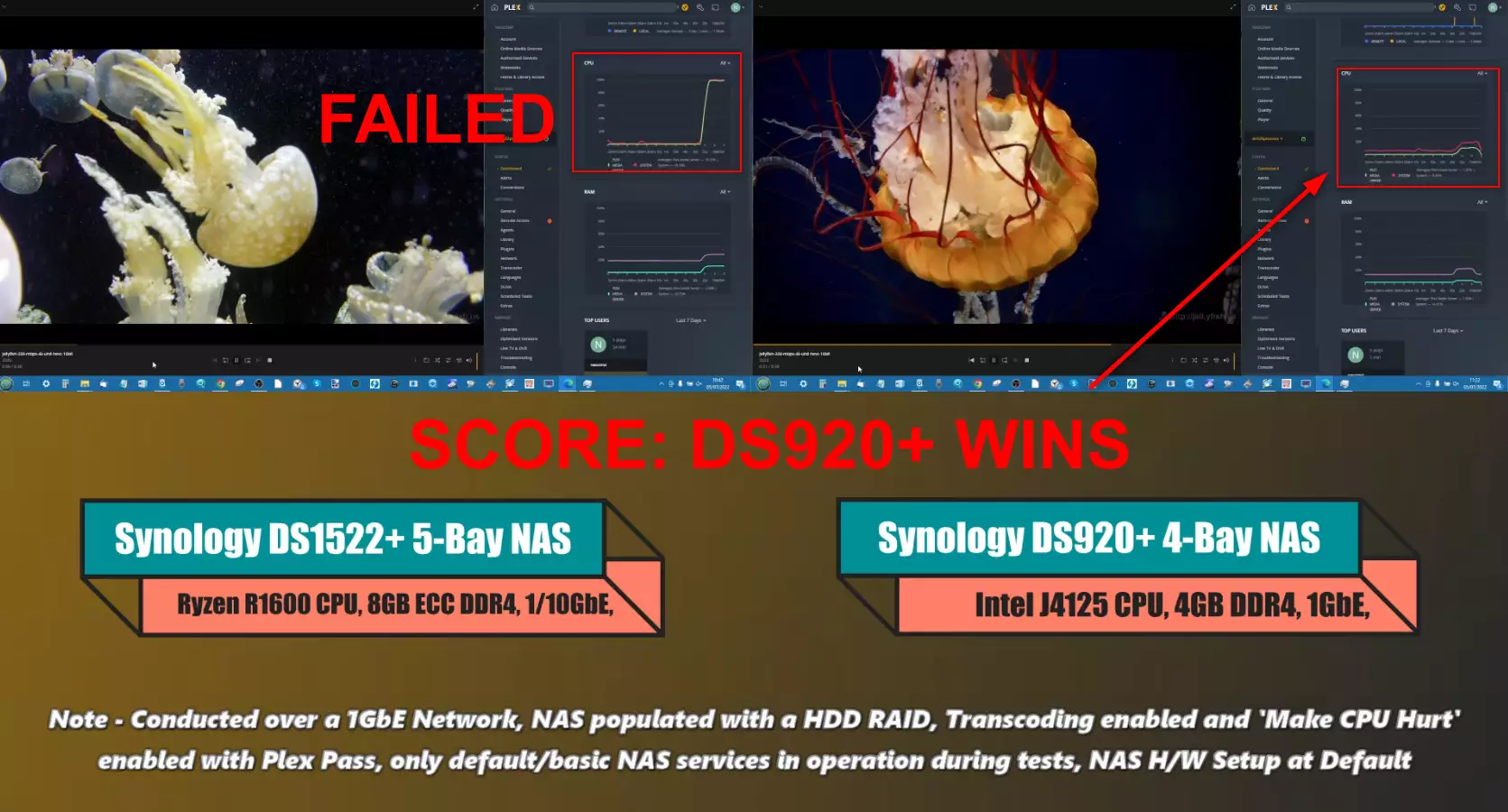
Yep, once again, that Intel J4125 Celeron CPU and it’s integrated graphics was able to get the converting/encoding done on the fly and win here. The AMD embedded Ryzen R1600 COULD have off-line transcoded for sure, but when it came on on-the-fly conversions, it just lacked the right tools on board. Want to watch more tests on either of these NAS drives IN PLEX? You can visit the links below to view the individual Plex Media Server tests for each of the DS920+ and DS1522+ NAS. These videos and articles include several more tests and go into more detail on the difference between H.264 and H.265/HEVC media, as well as further 1080p and 4K testing:
| Written Plex Test Articles | YouTube Plex NAS Test Videos |
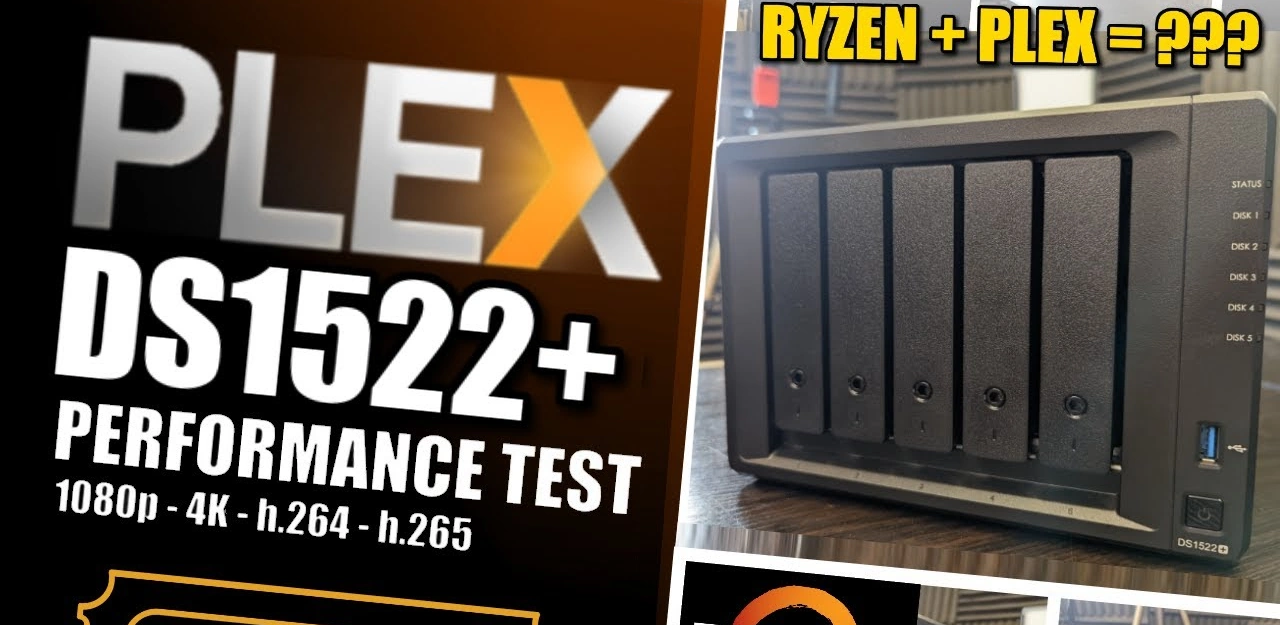 |
|
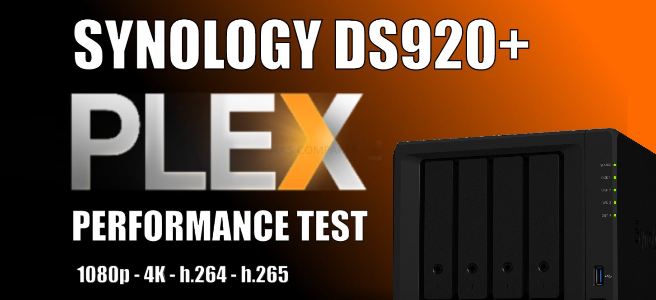 |
Synology DS920+ vs DS1522+ NAS – Conclusion and Verdict
Comparing the DS920+ from 2020 and DS1522+ from 2022 did seem a little unfair at first, as ALOT can happen in two years (technology moves FAST!). However, in terms of supporting multimedia, if you are looking at these two NAS drives SPECIFICALLY for Plex Media Server and Multimedia use, the older generation device with its Intel embedded graphics CPU just wins the day over the Embedded Ryzen R1600 from AMD. But either of these NAS devices presents a decent-sized financial investment and I think most users need to think about using them for MORE than just multimedia. Synology has clearly done a lot of thinking in the two years between the release of the DS920+ and DS1522+, deciding to change the latter into something more ‘business-y’. When the DS920+ first arrived, it did so to almost universal praise (barring a few concerns at the time about 1GbE) and it has pretty much always been in the top 3 NAS since its launch for most users. Although the details regarding a DS922+ or DS923+ are still not available at the time of writing, many wonder if it would emulate the change in direction that the brand has taken on the DS1522+ and whether the DS920+ is now even more attractive. Synology has clearly taken a rather different tactic in the release of their newest 5-Bay system, making changes to the expected hardware configuration and architecture that set it on a very different path than its predecessor. Those with longer memories will know that the Diskstation 5 Drive portfolio used to be very much this kind of design (i.e a file transfer focused CPU, more memory scaling, optional 10GbE, etc) and rather than building off the design of the 4-Bay (as the DS1520+ did against the DS920+), the DS1522+ seems to scale itself against the DS1621+ in it’s shape and abilities. If you were already looking at Synology NAS systems that being a heavy emphasis on scaling their architecture notably down the line in efforts to remain future proof, the DS1522+ is going to tick ALOT of boxes for you. Whereas if you were looking at a Synology NAS for home use, a Plex Media server, low client/user use and generally as more of a setup-and-forget solution, then the DS920+ will likely suit your needs better and will have the added benefit of a more palatable price point in 2022. How far Synology will extend the build logic of the DS1522+ towards other solutions in the diskstation/rackstation portfolio still remains to be seen. Most business users will want to opt for the DS1522+ though. Cheers for reading!
|
|
|
|
|
NAS MODEL ID |
Synology DS920+ NAS |
Synology DS1522+ NAS |
|
Where to Buy: |
 |
 |
Need More Help Choosing the right NAS?
Choosing the right data storage solution for your needs can be very intimidating and it’s never too late to ask for help. With options ranging from NAS to DAS, Thunderbolt to SAS and connecting everything up so you can access all your lovely data at the touch of a button can be a lot simpler than you think. If you want some tips, guidance or help with everything from compatibility to suitability of a solution for you, why not drop me a message below and I will get back to you as soon as possible with what you should go for, its suitability and the best place to get it. This service is designed without profit in mind and in order to help you with your data storage needs, so I will try to answer your questions as soon as possible.
📧 SUBSCRIBE TO OUR NEWSLETTER 🔔
🔒 Join Inner Circle
Get an alert every time something gets added to this specific article!
This description contains links to Amazon. These links will take you to some of the products mentioned in today's content. As an Amazon Associate, I earn from qualifying purchases. Visit the NASCompares Deal Finder to find the best place to buy this device in your region, based on Service, Support and Reputation - Just Search for your NAS Drive in the Box Below
Need Advice on Data Storage from an Expert?
Finally, for free advice about your setup, just leave a message in the comments below here at NASCompares.com and we will get back to you. Need Help?
Where possible (and where appropriate) please provide as much information about your requirements, as then I can arrange the best answer and solution to your needs. Do not worry about your e-mail address being required, it will NOT be used in a mailing list and will NOT be used in any way other than to respond to your enquiry.
Need Help?
Where possible (and where appropriate) please provide as much information about your requirements, as then I can arrange the best answer and solution to your needs. Do not worry about your e-mail address being required, it will NOT be used in a mailing list and will NOT be used in any way other than to respond to your enquiry.

|
 |
UGREEN NAS Now has iSCSI, 2FA and Jellyfin (and more) - FINALLY!
Seagate 30TB Ironwolf and EXOS Hard Drive Review
Why Do Cheap NAS Boxes EXIST????
Minisforum N5 Pro NAS - Should You Buy?
UGREEN DH4300 & DH2300 NAS Revealed - Good Value?
Aoostar WTR Max NAS - Should You Buy?
Access content via Patreon or KO-FI


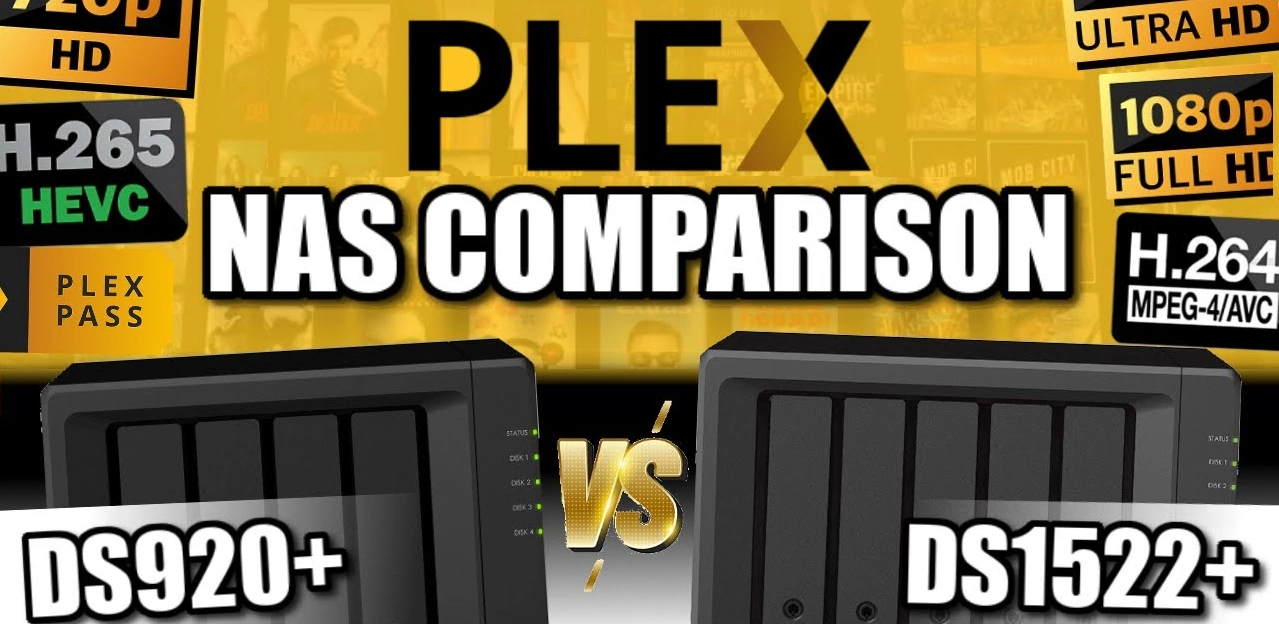
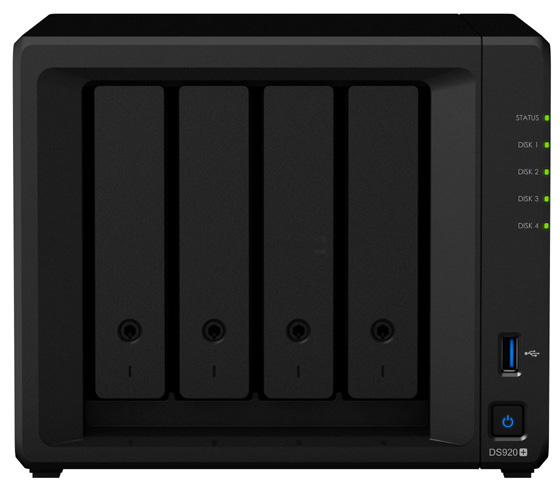
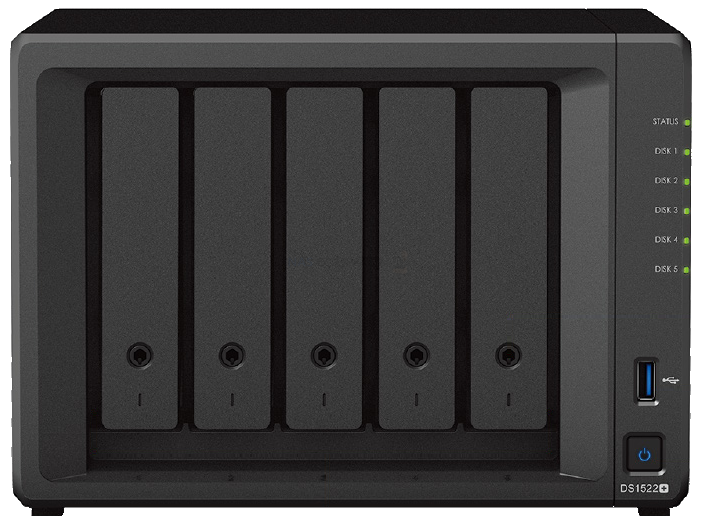




If I understand what you’re saying is that if you’re primarily watching within your own network with at least gigabit speed, and you’re using a renderer that can natively do HEVC/UHD (like an apple TV), it’s not really a problem since Plex can just stream the file to the endpoint. Is that roughly correct?
REPLY ON YOUTUBE
I really appreciate your explanation of transcoding. Thanks
REPLY ON YOUTUBE
Many thanks for the honest and hard work you two are doing. You guys rock! ????
REPLY ON YOUTUBE
we want more like this….
more comparasion with video real, not just talk only
REPLY ON YOUTUBE
OMG what is up with you people discounting this because it doesn’t provide enough gpu transcoding for you, therefore it’s a loser? I had a 220+ which was fine and now the 1522+ and it’s awesome. Plays all my 4K videos perfectly and as well or better than my previous. What is this obsession with transcoding videos when you’re buying a $1000 NAS that does so much more and the new processor does cartwheels around the previous Celeron on the 220+. I mean how many people are watching fricken videos on their phone and flipping out if it buffers? I tested and it works just as well as the 220+ for my needs, no buffering or stuttering and remote play just as seamless. So are there seriously tens of thousands of people using their NAS to share their library and expecting 10 for more simultaneous transcoding streams to all their kids or friends or…. customers? it’s lunacy to see all the complaints about this one feature not being optimized with their choice of a new CPU which frankly is so much faster and efficient on every other task I use my NAS for like video and photo editing on the fly, backing up and accessing Synologydrive, music streaming and everything else. And no problem playing and I guess transcoding a stream when needed. So just STFU with all the negative whiners who seem to have no life but watching multiple streams on multiple phones at any given time, therefore this is a crappy NAS? Give us a break and get a life. It’s an awesome product.
REPLY ON YOUTUBE
Hi all. I’m new here and I’m planning on buying this device and part of the use would be to stream my video to my Apple TV 4K. So here is my question. Can the Apple TV transcodes for me through the plex app if installed on it if needed?
REPLY ON YOUTUBE
I run my mac mini m2 pro 24/7 and plex on it. How will will the 1522+ run as just a storage device for plex server running on mac?
REPLY ON YOUTUBE
One thing I don’t understand is why the Server is struggling to serve a native format (e.g. Jellyfish 4k uhd, but h264). Isn’t it supposed to pass it directly through the network, and then the client tries to decode it?
REPLY ON YOUTUBE
Should I buy 920+ in 2023????
REPLY ON YOUTUBE
Can plex pass play the drm movies downloaded from Apple? I have quite a few movies that i bought the blu ray disc and it came with a digital copy which I redeemed the code through iTunes and nothing I’ve found will play it except of course streaming from my nas to iTunes. I can’t even stream it to my iPhone. Of course I know I can just stream it from apple on my iPhone, but the point is I want to be able to stream my own content that I own on my NAS. Thanks.
REPLY ON YOUTUBE
So glad I got the 920+ for my home/office. I stream lots of video over it, often over my phone on cell data while we’re traveling. Love that I’ve been streaming on 5 devices at a time and the 920+ handles it. Granted they’re all 720p and 1080p, but that’s still impressive doing multiple at a time and the processor is barely working.
REPLY ON YOUTUBE
Most of my devices can handle it without transcoding if not I’ll do dual plex server to a desktop.
REPLY ON YOUTUBE
You talked a lot of rubbish about the ssd’s for 10 minutes. It didn’t give anything!
You should speak about the handling, as looking at movies with Plex and so on. Have someone of them integrated graphics, etc. Rhstd relevant information!
REPLY ON YOUTUBE
Well-Done & you should tour london with your videos more often
REPLY ON YOUTUBE
Do we really need transcoding ? No. I have watched all the videos about Plex transcoding while looking to upgrade my old DS412+ that’s 10y old. I have even purchased the DS1520+ in order to get access to the old Intel CPU with GPU it order to be able to transcode. Looking more into things I realized that transcoding is not anymore important because nowadays the clients available are able to play pretty much everything. I returned my DS1520+ for a much faster DS1522+ and added to my living room a very nice Nvidia Shield TV Pro linked to my NAS. I am easily able to play Jellyfish 4K 400Mbps H.265 10bit with buffer increasing every second. The old DS412+ and Shield could even play the 4K files but not the 10bits ones because of a lack for throughput from the NAS. In conclusion, I am not sure about the pertinence of those transcoding test when you can simply upgrade your clients.
REPLY ON YOUTUBE
What a mess for Synology , its like they saying go buy the older version or a QNAP .
Totally MESS….
REPLY ON YOUTUBE
I have a DS1522+ coming but not the disks (will buy 20TB’ish as I can afford them 🙂 but can I just toss in some dumb old single drive just to get in and play around till the remaining drives get here (i have not made my mind what I want yet).
REPLY ON YOUTUBE
When I started my multimedia library, our computer was old and slow by today’s standards. So to avoid the “cpu fans of transcoding”, I transcoded the media to be compatible with our devices prior to adding to the library.
REPLY ON YOUTUBE
Just realized this is the answer of a question I posted some minutes ago on another video. You already have a video for it. Thank you so much! Seems like I need to wait some more years. Encoding/Decoding on the 1522+ is a bummer in addition to its slow built-in LAN ports. And I won’t by a 2,5 years old NAS. I want a long phase of support by the vendor.
REPLY ON YOUTUBE
Is this a downgrade from previous generations like the 1520+? I was thinking about switching from QNAP to Synology. This seems like another drawback in addition to their outdated 1 Gbits LAN connections. Probably I need to wait another couple of years.
REPLY ON YOUTUBE
I guess I bought the DS1522+ “Etzel” of NAS’s when it comes to Plex. However when I add media to my Plex library, I transcode it for the devices we broadcast to prior to adding. I did that so that my computer would not have to transcode everything on the fly. I don’t really think this will affect me much unless we become enamored with 4K media – that has not by any means caught-up with 1080P in content availability.
REPLY ON YOUTUBE
Watching 4k movies on my 920+ all the time. Don’t listen to this guy.
REPLY ON YOUTUBE
I found this videos informative but somehow hard to watch, they are kinda unorganized. No hate, just what I feel
REPLY ON YOUTUBE
It’s a shame the 1520+ is now end of life without another that is an equal / newer version to upgrade to
REPLY ON YOUTUBE
Wich Plex Version must install for Ds1522+
REPLY ON YOUTUBE
Very, very informative! I was on the fence between these two NAS and almost bought 1522+ but due to this video I decided not to.This video provided me the key and vital information which basically made decide to eighter go with the 920+ or wait until Synology comes out with a 5 bay NAS with the more powerful AMD Ryzen “AND” embedded graphics. Fingers crossed ????the 1523+ will have it. The only question I have is, is 5 bay NAS more future-proof than the 4 bay?
Thank you very much
Rey750cc
REPLY ON YOUTUBE
Fantastic comparison. I just got the DS1522+ (my very first NAS) primarily for Plex and I’m finding the same results as you that it will not play 4K movies. Luckily I only have a few 4K videos so it’s not a huge impact, but if I’d known this before my purchase I’d probably have gone with the DS920+.
REPLY ON YOUTUBE
intel xeon w-1250 6 core vs intel core i5-12400 6 core…. which is better for transcoding and encoding?
REPLY ON YOUTUBE
Conclusion: 19:03
REPLY ON YOUTUBE
Your channel rocks
REPLY ON YOUTUBE
Again, you skip the entire 4k segment that is the only format relevant for modern devices.
REPLY ON YOUTUBE
People… Transcoding is completely unnecessary these days!!! I have it on my server and on my phone but with WiFi and 4g and 5g data these days… Not necessary!!! If you worry about quality or cut outs??? Download a copy of it to your device!
REPLY ON YOUTUBE
……….WHEN will we see a DS922 or a DS923???
REPLY ON YOUTUBE
Why are we using Chrome and not the native App?
REPLY ON YOUTUBE
@NASCompares thank you for great content!
I’m in the middle between choosing between DS920+ and DS1522+, I wondering will DS1522+ without GPU handle VMs better (with the same amount of RAM)?
REPLY ON YOUTUBE
timeline is missing
REPLY ON YOUTUBE
So owned we know which side of Robbies bread is buttered by the people whose products he hawks even if they are inadequate by todays standards and consumer needs….Its always the same, no objectivity what so ever…..why people bother to listen to this toothless moron is beyond me…..NAS Compares should be called Synology/QNAP No Comparison Here
REPLY ON YOUTUBE
Is there a NAS that can be used for video, photo editing and storage? Currently use a DAS, BUT would love not to hear drive noise and use remotely wwhen at my other office?
REPLY ON YOUTUBE
oh gawd…it’s like the early days of Netflix online streaming…here goes my PTSD. lol.
REPLY ON YOUTUBE
Thanks for good info. Will definitely wait for the Synology DS923+ NAS in January?
My old DS1817+ will struggle on until then. 90% is PLEX use.
REPLY ON YOUTUBE
I only use my Nas as raw storage for my PC that runs Plex.
I use 4K Dolby Vision/HDR files regularly so my 9th Gen i3 paired with 16GB RAM plays everything flawlessly.
The NAS is just my big boy storage for noisy drives down the hallway.
I use a DS418
REPLY ON YOUTUBE
No test??
REPLY ON YOUTUBE
That’s very annoying. I was about a week away from buying one of these.
REPLY ON YOUTUBE
I am constantly having to restart PLEX on my TS-253D. Any suggestions?
REPLY ON YOUTUBE
Hello there. can you please give your views regarding my prospective project? I have one house in Spain and one in Thailand. How do I get best protection?
I was thinking to buy a Synology 6-bay NAS with 6 Seagate 20TB drives and a DX517 with 5 Seagate 20TB as a backup in Spain. Two surveillance cameras installed.
In Thailand a Synology 4-bay NAS with 4 Seagate 20TB drives. Two surveillance cameras installed.
I would like to get prompt wherever I am in, that being in Spain or Thailand, or elsewhere whenever I get a prompt from my NAS’s?
Any other suggestion for the project.
REPLY ON YOUTUBE
It would be really useful if you could highlight the general power consumption of the NAS units over time , I understand it’s complex and varies by use, but a general guide would be great – given the cost of electricity now – great channel 🙂
REPLY ON YOUTUBE
What about a slightly different use case: storing user created video from phone or a prosumer camera? For example, from an Apple iPhone. Then feeding video to Mac for Final Cut editing?
REPLY ON YOUTUBE
Damn R1600 and not a R1606G, maybe not the right cpu for the DS1522+
REPLY ON YOUTUBE
Hmm I was looking at grabbing DS1522+ from UK Amazon yesterday, and now only the DS1520+ is listed….
REPLY ON YOUTUBE
Looks like the new Ryzen 6800U would be a good match for the Synology. Low power and built in graphics. Although I’m not sure why they just don’t use a later generation Intel cpu. They must have gotten a better deal with the old Ryzen chips. “Old” being the keyword.
REPLY ON YOUTUBE
Happy with my 1520
REPLY ON YOUTUBE
I don’t understand why you keep saying the 920+ can’t play 4k files. I’ve been playing them (Blu-ray remuxes) for over a year and transcoding them with no problem at all. Sincerely you should revise your test methodology because you are just spouting false info there.
REPLY ON YOUTUBE
Am I correct to assume that the DS1520+ will peform similar to the DS920+, or am I overlooking something?
REPLY ON YOUTUBE
Why … I mean really why is there not a Ryzen 5000 series AMD APU NAS on the market.
Wouldn’t it absolutely own the ds920+?
Thanks for the content
REPLY ON YOUTUBE
When do you think we’ll see Ryzen/Vega on a Nas? Do you think that Plex will take advantage of the Vega iGPU?
REPLY ON YOUTUBE
So these playbacks are done through a browser, not the Plex app?
REPLY ON YOUTUBE
I just bought a 920+, it is awesome, but a Looooud Mfer. I will say the best plex setup is 10tb x4, perfect balance and performance
REPLY ON YOUTUBE
no timeline wtf?
REPLY ON YOUTUBE
Very enlightening comparison
REPLY ON YOUTUBE
Great video as usual.
Please can you do the same comparison testing Sinology Photos with big amount of photos and h.264, h.265 videos on the library?
Another one is to test the performance and CPU utilization difference in VM.
Just curious if there’s any scenario with performance gain in the Ryzen!
REPLY ON YOUTUBE
Thanks, I think I’ll keep my 1520+ for now ????
REPLY ON YOUTUBE
I’m a school photographer was is the best synology system? What hard drives you recommend that’s over 14TB? I am using Fiber from AT&T.
REPLY ON YOUTUBE
I bought a DS1520+ as it basically a 5 bay 920+ and have been very happy with it as my Plex Server. I was concerned at the switch to AMD and this confirms it. I hope there is a Plex friendly 5 bay when I come to upgrade in a few years.
REPLY ON YOUTUBE
Would you mind helping me out with understanding this a bit more ? ????
So I am going into this blindingly; I have two different NAS Diskstation Systems, that I’ve been thinking about purchasing and the reasoning for both is probably really stupid, which is why I am reaching out to ask for some useless information before blowing a bunch of money….
I am basically wanting to purchase one of these so I can have my 15+ tb music & music video collection ALL within one place instead of having multiple external HD.
The two that I am looking at are the DS1520 + and the DS920+.
I plan to purchase the maximum amount of storage that these can withhold with the Exos 16 tb HD. (So total of either 4 or 5 of those 16 tb HD). And then some time later on down the road i will purchase the expansion and max that one out as well and have all of my music collectively all on one of these NAS systems. Another thing to note is I plan to also purchase the Lifetime License for Plex as well.
If there are any upgrades that I can do to any of the two such as upgrade the RAM / add to the RAM or add a much better graphics card that will be dedicated to one of these please can you add that info in there as well.
Thank you
REPLY ON YOUTUBE
How about surveillance station. Will it make any difference there if the cpu has built in graphics? E.g. I have 6 cameras, 3 of them 4k. They are running perfectly on a DS718+.
REPLY ON YOUTUBE
Thank you. So if I get it, Rob said neither of these are ideal for 4k playback. So let’s forget transcoding for a minute. I am at home on my LAN and want to stream a 4K file to a 4K device. Which would be the best Synology NAS to do this? None? Or may be the potential upcoming DS922+ with an upgraded CPU and integrated graphics? The very expensive DS 1621xs+? I love Synology because of the software and really would hate to go somewhere else. Will Synology really abandon the prosumer niche and not have a NAS that can handle 4K video (via Plex)? Even without transcoding? Would welcome any idea or feedback. Thank you.
REPLY ON YOUTUBE
https://youtu.be/m3rbGoXUPUo
Not sure if you two follow each other, but your countryman has finally posted about his new Synology. Thought it would be of interest. –JB
REPLY ON YOUTUBE
my ds920+ came with a 120W power brick
REPLY ON YOUTUBE
What NAS would people recommend for 4K playback?
REPLY ON YOUTUBE
Very interesting as usual – Many thanks.
REPLY ON YOUTUBE
And if you use It as a file server with something like Zappiti or similar?
REPLY ON YOUTUBE
Blah blah blah blah blah blah just skip to 7:04 for the testing. Talk about a guy who can say so much with out saying hardly anything at all. Sheesh.
REPLY ON YOUTUBE
SO the one thing to note is yes the 920 is the best here, You can do it with the 1522 but that’s a single source stream soon as you multi-stream with transcode its a much bigger win in respect to how many transcoding streams a 920 can handle vs a 1522 regardless of how dense your collection is.
REPLY ON YOUTUBE
920+ FTW! Got it on your recommendation and I found it a great all-rounder. Plex, file backup, it does it all.
REPLY ON YOUTUBE
Thank you for making this absolutely fascinating video.. watched to the end, learning so much from you and your channel. ????from me – Neil (UK)
REPLY ON YOUTUBE
This isn’t the ideal use case for either device. What would be really interesting to see is how they compare in native app multitasking, perhaps VMs etc.
I still maintain the 1522 is a shameless downgrade not worth considering.
“Return YouTube dislike” addon for most browsers is what you want, Rob ????
REPLY ON YOUTUBE
So glad to go with DS1522+. Why? Ticks so many more boxes to be future proof. Cheapest Synology 10 GB Capable
They both struggle with Plex. So I move Plex to Mac Mini and it will encode any freaking video. Or constant struggle Playing 4K on 920+
REPLY ON YOUTUBE
So glad to go with 920+. Well done Rob.
REPLY ON YOUTUBE
I pull the trigger on the ds920+ and never regret it (so far).
REPLY ON YOUTUBE
So glad I got the DS920+
(Been wondering about the raw CPU When it comes to graphics performance and I guess I made the right decision)
REPLY ON YOUTUBE
Great presentation and even better attitude towards the end regarding your patrons. Well done!
REPLY ON YOUTUBE
Cannot find any direct comparison reviews of the DS1522+ vs DS1621+ . Anyone have any thoughts? The DS1621+ seems better because it can take a much cheaper 10GB PCI card and has a longer list of compatible drives, right? Not sure what else merits any advantages for the newer DS1522+. Anyone?
REPLY ON YOUTUBE
Id feel better about the DS920+ if the DX517 wasn’t so expensive for basically a hdd bus extension box. If you need/want that 5th bay upfront then getting the DS1520+/DS1522+ is a bit cheaper in the long run with twice the expandability later. The DS920+ ends up being cheaper than DX517 when on sale to the point you might as well get another DS920+ for the value rather than the extension DX517.
REPLY ON YOUTUBE
The sad thing is that the NAS world is still lagging behind when it comes to “transcoding”. With the UHD 6xx integrated GPUs on the CPUs, the Intel CPUs do not get hit as hard as the Ryzen 1600 when you try to play a HVEC/H.265 media file. And for $1,000 USD, the Synology DS1522+ is way over priced since it using an old Ryzen 1600.
REPLY ON YOUTUBE
TerraMaster with XPEnology loaded might be my future when I look for my 920+ replacement in 2024. I usually replace my NAS every 4 years with an upgraded model, while the old system still has 75% its value to help fund the upgrade.
REPLY ON YOUTUBE
Thank you for these benchmark videos. You’re really helping to prevent unhappy customers. If I get this one from your company, at least I know what the capabilities are and won’t be surprised or disappointed down the line. It also gives me more confidence in stepping up to a higher model without worrying that I’m wasting money.
REPLY ON YOUTUBE
Isn’t this the 2nd cycle Synology has downgraded things?
REPLY ON YOUTUBE
I mean… it honestly looks like a Mac Mini + Thunderbolt drive would be easier to play 4k media.
REPLY ON YOUTUBE
What Synology NAS would you recommend for Plex that can easily play 4k (w/ and without HDR) content?
Much appreciated!
REPLY ON YOUTUBE
What if you use a NUC that has a GPU or a beefier CPU with iGPU to run Plex server on it and just mount a volume from the DS1522+ that houses all the media?
REPLY ON YOUTUBE
@NASCompares Could you please do a video comparing the new 5-bay DS1522+ with the older 6-bay DS1621+/DS1621xs+ models? I am a home user trying to decide whether to move to a NAS and if so, whether to use a 5-bay or a 6-bay NAS. (I presently have a SANS Digital 5-bay USB RAID in a RAID5 and a Promise Pegasus R6 6-bay Thunderbolt RAID in a RAID6.)
REPLY ON YOUTUBE
HELP! If I don’t have any Synology NAS and this is disappointing for many, which Synology I should buy???
REPLY ON YOUTUBE
So in this price range, with minimum 5 disc, it is the best Plex media server product that is comfortable in 4k. What are the options?
REPLY ON YOUTUBE
Picked up a 1520+ last month for home use to replace my decade old ReadyNAS and no regrets. I was able to get rid of my dedicated plex server with quadro and loving all the features of synology like backup which I in fact use old ReadyNAS as a backup repository.
REPLY ON YOUTUBE
Finally, thanks for the testing. You’ve helped me make up my mind. I’m definitely sticking with a 1520+. I made a call to Synology, and had a long “talk” about the lack of an integrated GPU on the 1522+. No sensible response. Synology REALLY dropped the ball with this “upgrade”.
REPLY ON YOUTUBE
How is the performance if you are not doing any transcoding?
REPLY ON YOUTUBE
Was waiting for this one sir! TY kindly!
REPLY ON YOUTUBE
I did some tests as well at mine DS920+ and all are working good. the transcode from the HEVC works great.. and then im also running a lot VM and Dockers haha.. only the 4K will be get trouble yes.. that will be hard. further im very happy with my DS920+ still a very good machine and im really use a lot of applications on the NAS..
REPLY ON YOUTUBE
Thank you for this review, I was waiting for it, sad that this nas isn’t playing 4K that’s a big blocker for me… Real shame as I wanted to buy it ????????♂️ going to check out 920+ or the 1520+ instead… Who knows I might go nutz and get 1621+/xs ????????♂️
REPLY ON YOUTUBE
Following what I thought was a system failure on my Synology (very old DS412+), I was in a real bind for a couple of weeks. I was torn between replacing it with a DS920+ or waiting on the pending release of the much vaunted DS1522+. The agony!
In the end I needed my NAS, so I bought a DS920+.
I was originally sad, but having seen this review, and several others, I’m so glad I didn’t go down this rout. Bad Synology! Hope they learn the lesson for the next gen. The box fulfills two principle requirements: Fast, reliable storage for my photographic work, and media services. Of course the DS1522+ would likely have been the go-to box if storage was my only concern, but for now I’m very happy with the DS920+ box that provides me with storage and media provision very well indeed.
On a side note, having recovered all my data off the DS412+, I dropped the machine back to factory setting. I formatted all the disks, factory reset and re-installed the O/S. That perceived issue was subsequently fixed. Now I’ve got my new DS920+ as the backbone NAS and a DS420+ for archival file storage and a nominal backup resource.????
REPLY ON YOUTUBE
So disappointing, how does it handle Surveillance Station with H265 4K security cameras?
REPLY ON YOUTUBE
looking forward to the comparison. I feel that the 920 is the perfect NAS for Home User
REPLY ON YOUTUBE
I am still a bit confused tho. I have watched many of your vids now, and every time (and you even show it) how the ds1520+ (same nas as i have) has integrated graphics. But still, when i try to use video station, it always absolutely EATS my cpu even with hardware decoding on. I sometimes cant even watch a video without some hiccups. Do i need to activate hardware decoding somewhere else to?
REPLY ON YOUTUBE
21:56 Ehm… UHD is ≈ 4K. Don’t you mean bitrate?
REPLY ON YOUTUBE
Do you know when we can expect 922+?
REPLY ON YOUTUBE
synology is so disappointing for plex servers…
REPLY ON YOUTUBE
When you do the Emby test remember to use the diagnostics plug in so you get the user sessions tab, this gives you a lot more detail on how the CPU is doing while playing back a video.
REPLY ON YOUTUBE
I have my 1019+ for backup and Plex server ~ seems like I should stick with this than to get this model when I’m Plex focus ?
REPLY ON YOUTUBE
Thanks for the review, disappointing Synology put in a cpu that can’t handle 4K
REPLY ON YOUTUBE
As far as I know the Plex Web Application will buffer only a certain percentage for video playback while the Plex Application (for Windows) will buffer more or all of the footage when paused. At least that is what I was able to see when comparing the Web App and the Native App.
REPLY ON YOUTUBE
I’m interested in DVR functionality as well. I have 4KUHD, BluRay 1080P, and most importantly DVR files from a HDHomeRun network tuner. Especially the Mpeg2 and Transcode while recording performance.
REPLY ON YOUTUBE
Good video! btw thumbnail typing error? “DS1552+”
REPLY ON YOUTUBE
Enabling stats for nerds would be great for frames dropped
REPLY ON YOUTUBE
Guess I’m still sticking with my DS920+ for a while. Still works great for me
REPLY ON YOUTUBE
First!
Great video mate ????
REPLY ON YOUTUBE
Great job overall – but – DS1520+ is the proper compare. Whoops – there it is:
Synology DS1522+ vs DS1520+ NAS – Which Should You Buy? – YouTube
https://www.youtube.com/watch?v=YpKV2V79ksw
REPLY ON YOUTUBE
Great knowledgeable and detailed information, so a big thank you to you!!!
REPLY ON YOUTUBE
I have a ds718 and I want to upgrade to the ds1522. I wish Synology would release it. I’m trying to wait. I’m starting to get low on available memory.
REPLY ON YOUTUBE
Curious ???? if I took 2 HDD’s (SHR – striped) from my ageing DS215j and transplanted them into a multi-bay Synology would they need reformatted or could the SHR continue to be expanded / rebuilt without data loss ?… ????
REPLY ON YOUTUBE
Hi, what do you use to steam uncompressed 4K? The media boxes (Apple TV, mi box) just can’t handle things once in the really big 4K, for now only my laptop can play them properly
REPLY ON YOUTUBE
They have adapted the apple thought process. Claim it is so great now, BUT. only if you buy this proprietary upgrade… nickel and dime at every turn. I can build a server in an old pc case that is much faster, more storage options and faster… TIME TO THINK ABOUT walking away like I left apple.
REPLY ON YOUTUBE
Just want to say thanks because of your knowledge, I was able to install and now have a total of 20gb ram with the specified ram on my ds920+. It is truly a nice device.
REPLY ON YOUTUBE
Wow, it’s really hard to listen to you when you’re banging on the table.
Maybe you can get a mic stand?
REPLY ON YOUTUBE
I am still using my DS 710+
REPLY ON YOUTUBE
Waiting for the DVA1622 myself :-
REPLY ON YOUTUBE
BTRFS = Better FS not Butter FS ????
REPLY ON YOUTUBE
So how get a freaking 10Gb/s synology? how much I need pay for the cheaper 10Gb/s ???????????
REPLY ON YOUTUBE
Still using my ds918+ with 16gb. CPU a bit slow and only use older VMs on it, but it works, the memory is plenty for everything I need the nas to do with plex and others services I run on it and I also have the expansion bay runn with a total of 9 drives.
REPLY ON YOUTUBE
I still run my DS-918+ on 32GB of RAM. The soldered on 4GB on the DS-920+ was a “no bueno” for me.
REPLY ON YOUTUBE
DS922+ without soldered down stuff.
REPLY ON YOUTUBE
Still on the fence 🙂
REPLY ON YOUTUBE
I’m still running a DS416Play 4 bay and still going strong. I use it as a video/music/photo server with 36TB (4x12TB RAID5). The DS920+ is tempting since the price is reasonable. Can you remove the drives from the old unit and put them in the new one without having to start over from scratch?
REPLY ON YOUTUBE
I personally have the DS 1520+. You sir have made the comparison between 1520+ and 1522+ in a previous video. This
video was one of the best I have ever seen. You are a true professional. Thanks for this amazing content. Keep up the good work.
REPLY ON YOUTUBE
Price comparison is always interesting. It’s amazing how many people will balk at an extra $150 – 200 for a piece of what might be a piece of critical digital infrastructure for them; something with a 4-5 year life span and quite possibly more. And then go for the cheaper option. But, those same people will spend that same money at Starbucks in a single month. Maybe Synology should add whip cream and sprinkles…
REPLY ON YOUTUBE
Thank you for sharing!
REPLY ON YOUTUBE
Why not better compare the 1522+ to the 1520+? They have the same number of possible drives and they both ship with 8GB of RAM.
REPLY ON YOUTUBE
While my existing 920+ is still in service, I got tired of waiting for synology to include 10gb standard in the pro series nas’s and build my own for less then a new 920+ My suggestion is if you have the knowledge or desire make your own Nas.. Perhaps Synology will catch up in a few years.
REPLY ON YOUTUBE
@gandalf1124 – thats what I am saying. Do we think there’s still a chance of a DS922+ this year? I got new drives a couple months ago, just sitting on a self waiting.
REPLY ON YOUTUBE
I will stick with my DS1019+ Thx.
Maybe release with 10GbE standard with better CPU and I will look at the next 1.
Good vid.
REPLY ON YOUTUBE
How you think the DS1522+ compares to the DS1621+?
REPLY ON YOUTUBE
For me the 10Gb/s option settels it. The question is will the DS922+ have that if it ever arrives.
REPLY ON YOUTUBE
How many streams will the ds920+ transcode at the same time, though?
REPLY ON YOUTUBE
Well, I had hopes for Plex but unfortunately couldn’t figure out why I am limited to 360p streaming/transcoding while outside of my home network.
Due to war in Ukraine and my city was occupied, I left my home but my QNAP Plex server remained switched on there.
I am a free, non-premium, user. At another city where I am now my home cable internet connection is 100mbit. I have Installed a Plex client app to Samsung Tizen tv and my Sony PS4 but all of these clients shows a content from my home server in up to 360p only. Maybe I am dumb but for me the reason is unclear. Should I buy Premium pass? Or I had to make same port forwarding on my home wifi router before I abandoned home?
REPLY ON YOUTUBE
So I’ve just bought a ds920+ installed dsm7 and is up and running created pool and volume and have added media to the folder but won’t play anything unsupported audio files are mp4 and mvk also Plex beta can’t add files to it either ????
REPLY ON YOUTUBE